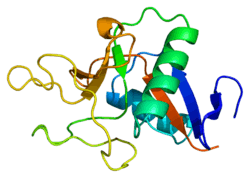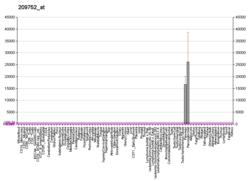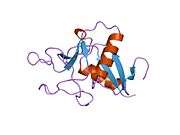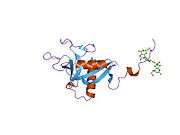REG1A
Pancreatic Stone Protein (PSP), also known as Lithostathine-1-alpha islet cells regeneration factor (ICRF) or islet of Langerhans regenerating protein (REG) is a protein that in humans is encoded by the REG1A gene as a single polypeptide of 144 amino acids further cleaved by trypsin to produced a 133 amino acid protein that is O-linked glycosylated on threonine 27. This protein is a type I subclass member of the Regenerating protein family. The Reg protein family is a multi protein family grouped into four subclasses, types I, II, III and IV based on the primary structures of the proteins. [5][6][7] Reg family members REG1B, REGL, PAP and this gene are tandemly clustered on chromosome 2p12 and may have arisen from the same ancestral gene by gene duplication.[7]. The PSP is mostly produced in Human by the acinar cells of the pancreas and is secreted in the duodenum by the same pathway that pancreatic exocrine enzymes. It has C-terminal C-type lectin domain whose binding partner is currently unknown.
Function
Pancreas development and regeneration
The PSP has been shown to be associated with islet cell regeneration and diabetogenesis and may be involved in pancreatic lithogenesis.
Sepsis
The blood PSP concentration has been shown to increase substantially in response to a sepsis event. Consequently, the use of the PSP as a biomarker of sepsis has been investigated thoroughly and the result of these researches confirmed the high diagnostic accuracy of the PSP for sepsis [8]. Of particular interest, PSP concentration has been shown to increase early in the development of a septic event, as illustrated in a cohort of severely burnt patients [9]
References
- GRCh38: Ensembl release 89: ENSG00000115386 - Ensembl, May 2017
- GRCm38: Ensembl release 89: ENSMUSG00000059654 - Ensembl, May 2017
- "Human PubMed Reference:". National Center for Biotechnology Information, U.S. National Library of Medicine.
- "Mouse PubMed Reference:". National Center for Biotechnology Information, U.S. National Library of Medicine.
- Watanabe T, Yonekura H, Terazono K, Yamamoto H, Okamoto H (Jun 1990). "Complete nucleotide sequence of human reg gene and its expression in normal and tumoral tissues. The gene encode protein, pancreatic stone protein, and pancreatic thread protein are one and the same product of the gene". J Biol Chem. 265 (13): 7432–9. PMID 2332435.
- Gharib B, Fox MF, Bartoli C, Giorgi D, Sansonetti A, Swallow DM, Dagorn JC, Berge-lefranc JL (Aug 1993). "Human regeneration protein/lithostathine genes map to chromosome 2p12". Ann Hum Genet. 57 (Pt 1): 9–16. doi:10.1111/j.1469-1809.1993.tb00882.x. PMID 8333731.
- "Entrez Gene: REG1A regenerating islet-derived 1 alpha (pancreatic stone protein, pancreatic thread protein)".
- Eggimann P, Que YA, Rebeaud F (Jan 2019). "Measurement of pancreatic stone protein in the identification and management of sepsis". Biomark Med. 12 (2): 135–145. doi:10.2217/bmm-2018-0194. PMID 30672312.
- Klein HJ, Niggemann P, Buehler PK, Lehner F, Schweizer R, Rittirsch D, Fuchs N, Waldner M, Steiger P, Giovanoli P, Reding T, Graf R, Plock JA (Jan 2020). "Pancreatic Stone Protein Predicts Sepsis in Severely Burned Patients Irrespective of Trauma Severity: A Monocentric Observational Study". Annal Surg. doi:10.1097/SLA.0000000000003784. PMID 31972652.
Further reading
- De Reggi M, Gharib B (2002). "Protein-X, Pancreatic Stone-, Pancreatic thread-, reg-protein, P19, lithostathine, and now what? Characterization, structural analysis and putative function(s) of the major non-enzymatic protein of pancreatic secretions". Curr. Protein Pept. Sci. 2 (1): 19–42. doi:10.2174/1389203013381233. PMID 12369899.
- Itoh T, Tsuzuki H, Katoh T, Teraoka H, Matsumoto K, Yoshida N, Terazono K, Watanabe T, Yonekura H, Yamamoto H (1990). "Isolation and characterization of human reg protein produced in Saccharomyces cerevisiae". FEBS Lett. 272 (1–2): 85–8. doi:10.1016/0014-5793(90)80454-Q. PMID 2226837.
- de la Monte SM, Ozturk M, Wands JR (1990). "Enhanced expression of an exocrine pancreatic protein in Alzheimer's disease and the developing human brain". J. Clin. Invest. 86 (3): 1004–13. doi:10.1172/JCI114762. PMC 296822. PMID 2394826.
- De Caro AM, Adrich Z, Fournet B, Capon C, Bonicel JJ, De Caro JD, Rovery M (1989). "N-terminal sequence extension in the glycosylated forms of human pancreatic stone protein. The 5-oxoproline N-terminal chain is O-glycosylated on the 5th amino acid residue". Biochim. Biophys. Acta. 994 (3): 281–4. doi:10.1016/0167-4838(89)90305-1. PMID 2493268.
- Giorgi D, Bernard JP, Rouquier S, Iovanna J, Sarles H, Dagorn JC (1989). "Secretory pancreatic stone protein messenger RNA. Nucleotide sequence and expression in chronic calcifying pancreatitis". J. Clin. Invest. 84 (1): 100–6. doi:10.1172/JCI114128. PMC 303958. PMID 2525567.
- Stewart TA (1989). "The human reg gene encodes pancreatic stone protein". Biochem. J. 260 (2): 622–3. doi:10.1042/bj2600622. PMC 1138718. PMID 2764894.
- Terazono K, Yamamoto H, Takasawa S, Shiga K, Yonemura Y, Tochino Y, Okamoto H (1988). "A novel gene activated in regenerating islets". J. Biol. Chem. 263 (5): 2111–4. PMID 2963000.
- Rouimi P, Bonicel J, Rovery M, De Caro A (1987). "Cleavage of the Arg-Ile bond in the native polypeptide chain of human pancreatic stone protein". FEBS Lett. 216 (2): 195–9. doi:10.1016/0014-5793(87)80688-9. PMID 3108036.
- Rouimi P, de Caro J, Bonicel J, Rovery M, de Caro A (1988). "The disulfide bridges of the immunoreactive forms of human pancreatic stone protein isolated from pancreatic juice". FEBS Lett. 229 (1): 171–4. doi:10.1016/0014-5793(88)80820-2. PMID 3345835.
- Montalto G, Bonicel J, Multigner L, Rovery M, Sarles H, De Caro A (1987). "Partial amino acid sequence of human pancreatic stone protein, a novel pancreatic secretory protein". Biochem. J. 238 (1): 227–32. doi:10.1042/bj2380227. PMC 1147119. PMID 3541906.
- De Caro AM, Bonicel JJ, Rouimi P, De Caro JD, Sarles H, Rovery M (1987). "Complete amino acid sequence of an immunoreactive form of human pancreatic stone protein isolated from pancreatic juice". Eur. J. Biochem. 168 (1): 201–7. doi:10.1111/j.1432-1033.1987.tb13405.x. PMID 3665916.
- Gross J, Carlson RI, Brauer AW, Margolies MN, Warshaw AL, Wands JR (1986). "Isolation, characterization, and distribution of an unusual pancreatic human secretory protein". J. Clin. Invest. 76 (6): 2115–26. doi:10.1172/JCI112216. PMC 424321. PMID 3908481.
- Perfetti R, Hawkins AL, Griffin CA, Egan JM, Zenilman ME, Shuldiner AR (1994). "Assignment of the human pancreatic regenerating (REG) gene to chromosome 2p12". Genomics. 20 (2): 305–7. doi:10.1006/geno.1994.1173. PMID 8020983.
- Otonkoski T, Mally MI, Hayek A (1994). "Opposite effects of beta-cell differentiation and growth on reg expression in human fetal pancreatic cells". Diabetes. 43 (9): 1164–6. doi:10.2337/diabetes.43.9.1164. PMID 8070617.
- Moriizumi S, Watanabe T, Unno M, Nakagawara K, Suzuki Y, Miyashita H, Yonekura H, Okamoto H (1994). "Isolation, structural determination and expression of a novel reg gene, human regI beta". Biochim. Biophys. Acta. 1217 (2): 199–202. doi:10.1016/0167-4781(94)90035-3. PMID 8110835.
- Bartoli C, Gharib B, Giorgi D, Sansonetti A, Dagorn JC, Bergé-Lefranc JL (1993). "A gene homologous to the reg gene is expressed in the human pancreas". FEBS Lett. 327 (3): 289–93. doi:10.1016/0014-5793(93)81006-L. PMID 8348956.
- Bertrand JA, Pignol D, Bernard JP, Verdier JM, Dagorn JC, Fontecilla-Camps JC (1996). "Crystal structure of human lithostathine, the pancreatic inhibitor of stone formation". EMBO J. 15 (11): 2678–84. doi:10.1002/j.1460-2075.1996.tb00628.x. PMC 450203. PMID 8654365.
- Patard L, Stoven V, Gharib B, Bontems F, Lallemand JY, De Reggi M (1997). "What function for human lithostathine?: structural investigations by three-dimensional structure modeling and high-resolution NMR spectroscopy". Protein Eng. 9 (11): 949–57. doi:10.1093/protein/9.11.949. PMID 8961348.







